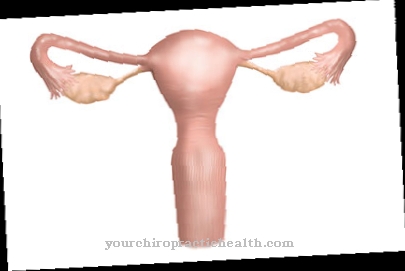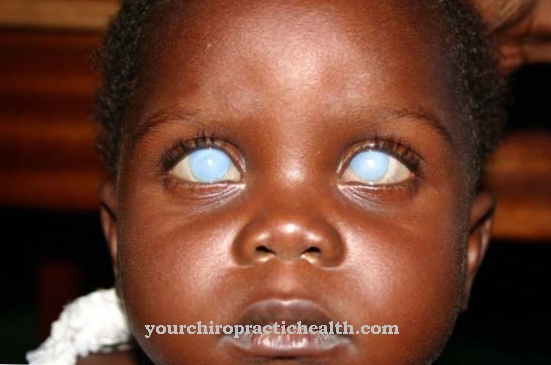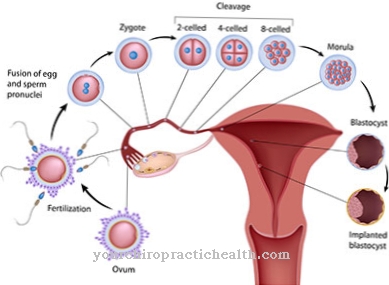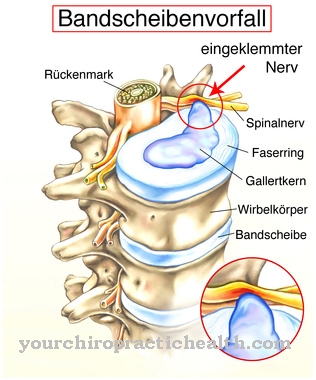A Hypesthesia (Sensory disorder) leads to a reduced perception of stimuli because the transmission of stimuli to the central nervous system is disturbed. The extent to which these symptoms can be treated depends on the underlying diseases. It is important to treat this as successfully as possible in order to eliminate the cause of hypoesthesia.
What is hypoesthesia?

© Antonioguillem - stock.adobe.com
A reduced sensation of touch or pain as well as a sensory disorder and sensitivity to irritation, especially in the area of the skin, is neurologically called Hypesthesia (Numbness) designated. Hypesthesia is therefore one of the sensory disorders.
These disturbances lead to the fact that the nerve endings as well as receptors and sensors, but also the eyes, ears as well as the nose and mouth as our sensory organs, no longer perceive the emotional stimuli correctly. It automatically follows from this that there is no correct transmission to the central nervous system (CNS).
From this point on, those affected can no longer distinguish between mechanical sensations such as pressure, temperature differences and vibrations, but also pain.
A distinction is made between four (five) forms of hypoesthesia:
- tactile hypesthesia with reduced sensation of touch and pressure
- with thermal hypesthesia there is a reduced sensation of heat and cold
- with hypalgesia there is a reduced feeling of pain
- Pallhypesthesia manifests itself through a reduced sensation of vibrations
- anesthesia describes the complete loss of sensitivity.
It is entirely possible that other symptoms will appear at the same time.
causes
Hypesthesia can be caused by different factors. The following causes can be considered as triggers, such as skin damage, for example from burns, polyneuropathy (systemic damage to peripheral nerves), peripheral nerve lesions or a cerebral infarction (somatosensory cortex).
Intoxications, i.e. the effects of harmful substances of a biological, chemical or physical nature on the organism or ischemia (reduced or decreased blood flow to tissue due to insufficient arterial blood supply) can trigger hypoesthesia.
It is just as possible that a herniated disc leads to sensory disorders. Permanent or recurring pressure on the nerve root causes pain and then numbness in the supply area.
The inadequate supply of blood, oxygen, and nutrients to the brain during a stroke can also be considered. Nerve failure can lead to numbness in the arms and / or legs.
Shingles and Lyme disease can also lead to a numb feeling in the body as infections. A vitamin B12 deficiency can damage the central nervous system and, in addition to tiredness and poor concentration, lead to numbness in the hands and feet.
If the numbness occurs in the head or face, it can be a beginning migraine attack or a brain tumor. It is therefore of great importance to consult the doctor in the event of persistent or recurring numbness, so that appropriate therapy can be initiated as early as possible. Further investigations are required if there are any initial suspicions.
Symptoms, ailments & signs
The numbness usually occurs in the limbs, less often in the head or body area.It can be felt in both legs or arms, or it can be one-sided. Half-sided expansions in the body are also known.
The numbness can occur together with various accompanying symptoms such as visual disturbances, pain, speech disorders and balance problems. If the numbness subsides, there is almost always a tingling sensation in the affected area.
Diagnosis & course of disease
The diagnosis is based on the most accurate history possible. Decisive questions for the doctor are the areas of the body where the numbness has occurred, since when the numbness has existed, in which situations it occurs. It is also crucial whether the numbness is unilateral or bilateral, whether it persists or decreases again and whether it comes back.
Furthermore, the doctor checks to what extent basic diseases are known. Those affected are tested for balance, hearing, vision and awareness. Further examinations such as blood tests, computed tomography, electroneurography and x-ray examinations must be carried out depending on the suspected diagnosis.
The course of the disease is shown by unilateral or bilateral numbness in certain local areas of the body. In extreme cases, a total loss of sensitivity, anesthesia, can occur. Pain in the affected areas is also often described in advance. It is not uncommon for concomitant diseases to occur.
Complications
Hypesthesia leads to disorders of sensitivity and stimulus perception. The affected person is therefore considerably restricted in his everyday life, since normal and everyday stimuli are no longer correctly or completely no longer absorbed. This leads to numbness in different regions of the body, which can also affect the legs.
In this case, there are significant restrictions on movement. The arms and fingers can also be affected by the paralysis, so that normal activities can no longer be carried out. It is not uncommon for the patient to rely on the help of other people to cope with everyday life due to hypesthesia.
Furthermore, symptoms of the eyes or ears can occur, so that the patient suffers from visual disturbances, for example. Speech disorders also occur. Mental confusion can also occur in severe cases. The treatment of hypesthesia is always causal.
Complications usually arise when the hypesthesia is not treated for a long period of time, which can lead to irreversible consequential damage. The treatment uses antibiotics to reduce the underlying inflammation. Furthermore, the patient is often dependent on therapies, although there are no further complications.
When should you go to the doctor?
Hypesthesia should always be treated by a doctor. As a rule, there is no self-healing and usually the symptoms worsen if no treatment is initiated. A doctor should be consulted if numbness or various sensory disorders in the body occur. These mostly occur on the limbs, but can also affect the head.
It is not uncommon for hypesthesia to lead to sudden visual disturbances or to pain, although language difficulties can also indicate the disease. If these symptoms occur without a reason and do not go away on their own, a doctor should definitely be consulted. Those affected may also have problems with their balance and suffer from a permanent tingling sensation in the affected regions.
First and foremost, the general practitioner should be consulted in the case of hypesthesia. They can diagnose the disease and initiate treatment, which may require the support of other specialists.
Doctors & therapists in your area
Treatment & Therapy
After taking a detailed anamnesis with findings, a differentiated treatment can take place, which must be specifically tailored to the problem at hand. The focus is always on eliminating the cause. Infection-based deafness is usually treated with antibiotics depending on the cause.
If diabetes is the trigger, the blood sugar level is adjusted. In the case of causative polyneuropathy, the symptoms are treated as best as possible, since the cause cannot yet be treated. However, good approaches are achieved in the context of a TCM treatment with acupuncture.
If a herniated disc is the trigger, orthopedic or surgical treatment is given to remedy the cause. Physiotherapy is also possible. In the case of migraines, the ENT doctor and / or neurologist is called in. If there is shingles or borreliosis or a vitamin B12 deficiency, internal treatment is required to resolve the cause.
The stroke belongs to the neurological or neurosurgical treatment. In the case of carpal tunnel syndrome or ulnar tunnel syndrome, conservative treatment can be given by an orthopedic surgeon and physiotherapist or chiropractor. If this treatment is unsuccessful, the surgeon should be called in.
You can find your medication here
➔ Medicines for paresthesia and circulatory disordersprevention
The best prevention is to avoid the diseases that can cause hypoesthesia. This includes a balanced diet to prevent vitamin B12 deficiency. Exercise so that the bony structure of the body gets enough support from strengthened muscles and lots of movement so that circulatory disorders do not even occur. If triggering factors are noticed, a doctor should be consulted immediately. A complete check-up, at least once a year, is helpful to identify pathological changes at an early stage.
Aftercare
The follow-up care for hypoesthesia depends on the disease causing it. Doctors often recommend a healthy diet to prevent vitamin deficiency. Adjusting your previous diet is particularly useful if there is a connection with diabetes. In the course of the follow-up treatment, any changes in the organism must be checked.
Those affected should therefore have a check-up carried out at least once a year. After the therapy itself, it is also important to adjust the medication if necessary. This reduces the risk that typical numbness will occur. If the disease was triggered by a herniated disc, the doctor usually recommends physiotherapy.
The point here is to move enough to strengthen the muscles and thus avoid the circulatory disorders caused by the disease. Depending on the degree of illness and the course of further development, gentle exercises can often help. Massage or acupuncture may also be useful as part of the aftercare.
There are other approaches available than conventional medicine offers. Among other things, some methods of Chinese medicine have led to noticeable success. Precise compliance with the medical recommendations should be a matter of course for the patient.
You can do that yourself
In the case of hypesthesia, the most important self-help measure is to determine the causal disease and to treat it specifically. If the symptoms are caused by diabetes, the diet may have to be changed. Changing medication can also reduce numbness under certain circumstances.
If the symptoms occur as a result of a herniated disc, physiotherapeutic treatment is indicated, which can be supported by those affected by gentle sport and suitable exercises. In some cases, hypoesthesia can be treated symptomatically with massage or acupuncture. Methods from Chinese medicine also bring relief. The use of alternative treatment methods should always be carried out in consultation with the doctor. In this way complications can be avoided and hypoesthesia can be treated optimally and in a targeted manner.
If the numbness has a serious cause such as a stroke, the affected person must be cared for on an outpatient basis or in a nursing home. The traumatic experience can be dealt with in therapy. The doctor can often establish contact with other affected persons if the patient so wishes. In the case of serious causes, hypoesthesia is usually treated with medication. Regular visits to the doctor and the preparation of an illness diary are the most important measures in this case.

















.jpg)







.jpg)


